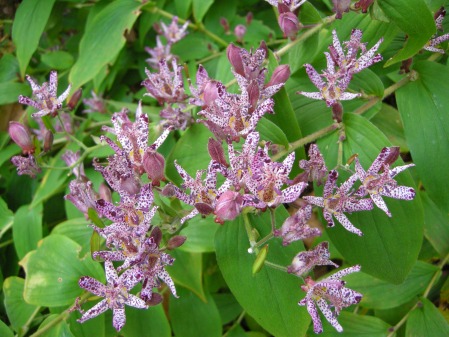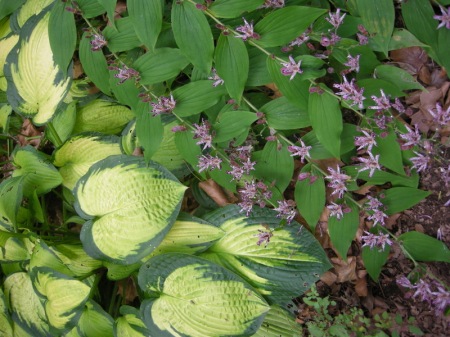Carolyn’s Shade Gardens is a retail nursery located in Bryn Mawr, PA, specializing in showy, colorful, and unusual plants for shade. The only plants that we ship are snowdrops within the US. For catalogues and announcements of local events, please send your full name, mailing address, and cell number to carolyn@carolynsshadegardens.com and indicate whether you are interested in snowdrops, hellebores, and/or hostas. Click here to get to the home page of our website for catalogues and information about our nursery and to subscribe to our blog.
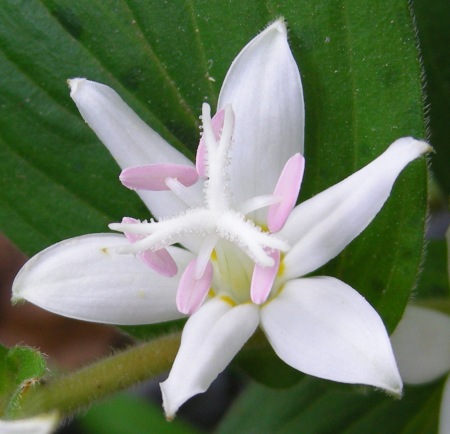 The subtle coloring of ‘White Towers’ toad-lily, Tricyrtis latifolia ‘White Towers’, is magical in the fall. Every photo was taken at Carolyn’s Shade Gardens this fall.
The subtle coloring of ‘White Towers’ toad-lily, Tricyrtis latifolia ‘White Towers’, is magical in the fall. Every photo was taken at Carolyn’s Shade Gardens this fall.
I am linking this post to Garden Blogger’s Bloom Day for October when gardeners around the world show photos of what’s blooming in their gardens (follow the link to see photographs from other garden bloggers assembled by Carol at May Dreams Gardens). I am also linking to Gesine’s Bloom Day at Seepferds Garten. I am located in Bryn Mawr (outside Philadelphia), Pennsylvania, U.S., and zone 6b.
In my last post, A Few Fall Favorites for Foliage and Fruit, I explained that, inspired by an article about dressing up your fall garden with mums because everything else is finished, I grabbed my camera and headed outside to prove them wrong. There was so much going on that I divided the plants into three posts: foliage and fruit, flowers, and hostas for fall. This is part two highlighting flowers. So here are some of the flowers dressing up my shady gardens right now:
 Japanese anemones, Anemone x hybrida, are one of the undisputed stars of my fall garden, growing anywhere from full sun to almost full shade and thriving no matter what the weather. Clockwise from upper left: ‘Honorine Joubert’, ‘Margarete’, ‘Whirlwind’, ‘Bodnant Burgundy’, ‘September Charm’.
Japanese anemones, Anemone x hybrida, are one of the undisputed stars of my fall garden, growing anywhere from full sun to almost full shade and thriving no matter what the weather. Clockwise from upper left: ‘Honorine Joubert’, ‘Margarete’, ‘Whirlwind’, ‘Bodnant Burgundy’, ‘September Charm’.
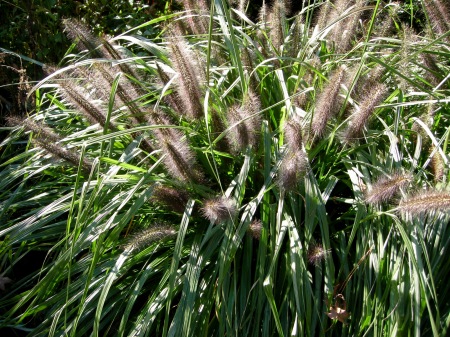 The black plumes of ‘Moudry’ fountain grass, Pennisetum alopecuroides ‘Moudry’, glow in the low-angled fall light. ‘Moudry’ does well in the shade, flowering later and remaining more compact.
The black plumes of ‘Moudry’ fountain grass, Pennisetum alopecuroides ‘Moudry’, glow in the low-angled fall light. ‘Moudry’ does well in the shade, flowering later and remaining more compact.
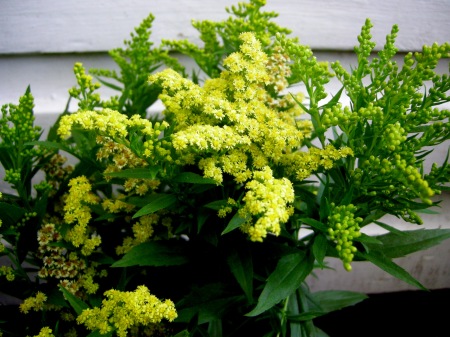 I grow about five different varieties of native golden rod, Solidago, with my current favorite ‘Little Lemon’, growing only 12 to 18″ high. Contrary to popular belief, goldenrod does not cause allergies as it is pollinated by insects. Wind pollinated ragweed, which blooms at the same time, is the culprit.
I grow about five different varieties of native golden rod, Solidago, with my current favorite ‘Little Lemon’, growing only 12 to 18″ high. Contrary to popular belief, goldenrod does not cause allergies as it is pollinated by insects. Wind pollinated ragweed, which blooms at the same time, is the culprit.
 Toad-lilies, Tricyrtis, bloom throughout the fall in full shade with ‘Sinonome’ just getting started now and continuing into November. Clockwise from upper left: ‘Sinonome’, ‘White Towers’, ‘Miyazaki’, ‘Empress’.
Toad-lilies, Tricyrtis, bloom throughout the fall in full shade with ‘Sinonome’ just getting started now and continuing into November. Clockwise from upper left: ‘Sinonome’, ‘White Towers’, ‘Miyazaki’, ‘Empress’.
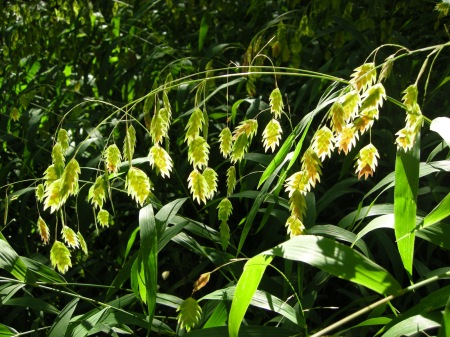 Another plant that is just warming up is Pennsylvania native northern sea oats, Chasmanthium latifolium. Its foliage will turn orange later in the fall and then dry to a beautiful khaki for the winter. Be forewarned, however, when this plant reaches critical mass, it starts spreading, and its wiry roots are very difficult to remove. Give it room and then triple the space you think you need.
Another plant that is just warming up is Pennsylvania native northern sea oats, Chasmanthium latifolium. Its foliage will turn orange later in the fall and then dry to a beautiful khaki for the winter. Be forewarned, however, when this plant reaches critical mass, it starts spreading, and its wiry roots are very difficult to remove. Give it room and then triple the space you think you need.
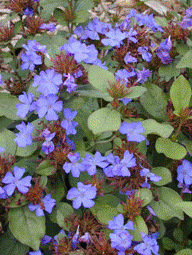 Autumn leadwort, Ceratostigma plumbaginoides, is one of my favorite groundcovers. Its true blue flowers start blooming in June and continue through October when its leaves turn bright red.
Autumn leadwort, Ceratostigma plumbaginoides, is one of my favorite groundcovers. Its true blue flowers start blooming in June and continue through October when its leaves turn bright red.
 Pennsylvania native ‘Bluebird’ smooth aster, A. laevis ‘Bluebird’, seeds all around my garden in full sun to part shade. Butterflies and bees love it. Please click here to find out why most native cultivars are just as friendly to native fauna as the species.
Pennsylvania native ‘Bluebird’ smooth aster, A. laevis ‘Bluebird’, seeds all around my garden in full sun to part shade. Butterflies and bees love it. Please click here to find out why most native cultivars are just as friendly to native fauna as the species.
 ‘Zebrina’ hollyhock mallow, Malva sylvestris ‘Zebrina’, seems to move around my garden at will, but it never fails to steal the show with its 3 to 4′ stalks loaded with showy flowers. It grows best in full to part sun.
‘Zebrina’ hollyhock mallow, Malva sylvestris ‘Zebrina’, seems to move around my garden at will, but it never fails to steal the show with its 3 to 4′ stalks loaded with showy flowers. It grows best in full to part sun.
 Fall-blooming hardy cyclamen, Cyclamen hederifolium, is one of the plants I would take to my shady “desert island”. Right now its pink or white flowers are floating all around my shady gardens. Later its evergreen leaves will emerge from summer dormancy and look like the photo on the left all winter long.
Fall-blooming hardy cyclamen, Cyclamen hederifolium, is one of the plants I would take to my shady “desert island”. Right now its pink or white flowers are floating all around my shady gardens. Later its evergreen leaves will emerge from summer dormancy and look like the photo on the left all winter long.
 I am always raving about the foliage of the coral bell cultivars derived from our Pennsylvania native Heuchera villosa. Well this is the plant that started it all, Heuchera villosa ‘Autumn Bride’. It has very large and attractive fuzzy green leaves and beautiful flowers that bloom right now–this is the only cultivar I would grow for its flowers (the rest I grow for the leaves).
I am always raving about the foliage of the coral bell cultivars derived from our Pennsylvania native Heuchera villosa. Well this is the plant that started it all, Heuchera villosa ‘Autumn Bride’. It has very large and attractive fuzzy green leaves and beautiful flowers that bloom right now–this is the only cultivar I would grow for its flowers (the rest I grow for the leaves).
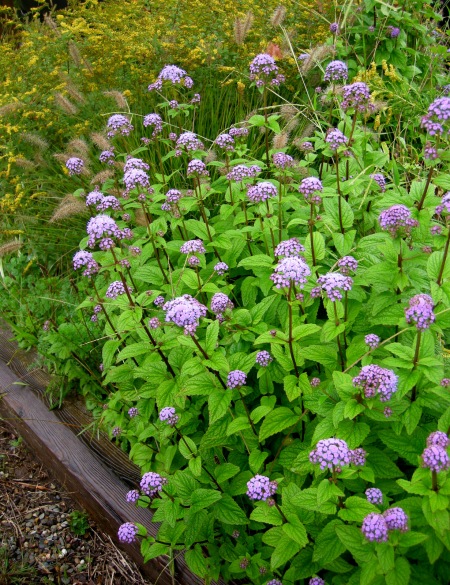 The cultivar ‘Cory’ of Pennsylvania native hardy ageratum, Eupatorium coelestinum, is far superior to the straight species. It has more abundant and showier flowers, ornamental purple stems, interesting crinkled leaves, and a much better upright habit. ‘Cory’ is also a good spreader in sun to part shade so give it room. Pictured above with another of my favorite Pennsylvania natives, wrinkleleaf goldenrod, Solidago rugosa ‘Fireworks’.
The cultivar ‘Cory’ of Pennsylvania native hardy ageratum, Eupatorium coelestinum, is far superior to the straight species. It has more abundant and showier flowers, ornamental purple stems, interesting crinkled leaves, and a much better upright habit. ‘Cory’ is also a good spreader in sun to part shade so give it room. Pictured above with another of my favorite Pennsylvania natives, wrinkleleaf goldenrod, Solidago rugosa ‘Fireworks’.
 Hardy begonias, Begonia grandis, have spread all over my garden in full shade, and I have yet to find a place that I don’t want them. Because they come up very late in May and really just get going in the fall, I use them to fill in between my hostas on my back hill.
Hardy begonias, Begonia grandis, have spread all over my garden in full shade, and I have yet to find a place that I don’t want them. Because they come up very late in May and really just get going in the fall, I use them to fill in between my hostas on my back hill.
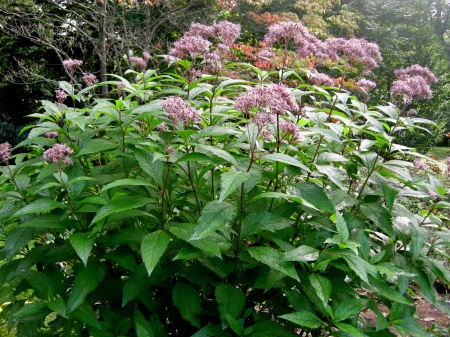 Pennsylvania native Joe Pye weed, Eupatorium dubium, reaches 10′ tall in my garden and flops over in our torrential rains. The “dwarf” version called ‘Little Joe’ grows to a diminutive 5′ tall and has remained erect through the 30″ of rain we had in August and September to bloom now with its large purple flowers–a magnet for butterflies and bees.
Pennsylvania native Joe Pye weed, Eupatorium dubium, reaches 10′ tall in my garden and flops over in our torrential rains. The “dwarf” version called ‘Little Joe’ grows to a diminutive 5′ tall and has remained erect through the 30″ of rain we had in August and September to bloom now with its large purple flowers–a magnet for butterflies and bees.
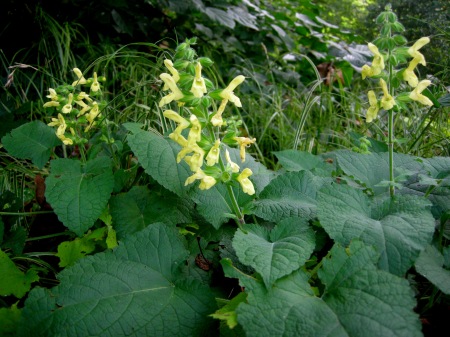 In the spring, a gardener I very much admire brought over this plant, telling me it was a salvia with yellow flowers that grows in full shade and blooms in the fall. I duly planted it in my shady “yellow garden” and it thrived through heat, drought, and rain with no attention. It is called woodland sage, Salvia koyamae.
In the spring, a gardener I very much admire brought over this plant, telling me it was a salvia with yellow flowers that grows in full shade and blooms in the fall. I duly planted it in my shady “yellow garden” and it thrived through heat, drought, and rain with no attention. It is called woodland sage, Salvia koyamae.
 I am just beginning to learn about hydrangeas because until last year there was no point in planting them because of the deer. One of my first acquisitions after the netting went up was ‘Limelight’, Hydrangea paniculata ‘Limelight’. The large white flowers aging to pink have been blooming all summer in part shade, and there are still buds coming—very impressive.
I am just beginning to learn about hydrangeas because until last year there was no point in planting them because of the deer. One of my first acquisitions after the netting went up was ‘Limelight’, Hydrangea paniculata ‘Limelight’. The large white flowers aging to pink have been blooming all summer in part shade, and there are still buds coming—very impressive.
 If you want a multitude of fall flowers in dry, full shade, you can’t find a better plant than Pennsylvania native blue wood aster, Aster cordifolius. It fills in all the difficult sites in my woodland and produces a glorious blue haze in the fall.
If you want a multitude of fall flowers in dry, full shade, you can’t find a better plant than Pennsylvania native blue wood aster, Aster cordifolius. It fills in all the difficult sites in my woodland and produces a glorious blue haze in the fall.
 It is fitting that I should end with my favorite Pennsylvania native perennial for fall, garden phlox, Phlox paniculata. I love everything about garden phlox: its heavenly fragrance, its long bloom time from early summer through fall, the wealth of colors available, its polite self-sowing, and its attraction to butterflies. I dream of installing a meadow area and collecting dozens of plants of every phlox cultivar out there!
It is fitting that I should end with my favorite Pennsylvania native perennial for fall, garden phlox, Phlox paniculata. I love everything about garden phlox: its heavenly fragrance, its long bloom time from early summer through fall, the wealth of colors available, its polite self-sowing, and its attraction to butterflies. I dream of installing a meadow area and collecting dozens of plants of every phlox cultivar out there!
Of the 17 photos above, 8 picture plants that are native to Pennsylvania and eastern North America. I believe that planting native plants is crucial to our survival. Please take the time to read this short essay explaining why. And Pennsylvania’s native plants really come into their own in the fall eliminating the need for dressing with mums!
Carolyn
To read Part 1, A Few Fall Favorites for Foliage and Fruit, click here. Stay tuned for Part 3, Hostas for Fall. In the interest of full disclosure, I must confess that sadistic botanists have recently changed the botanical names of many of the native plants that I highlighted to completely unpronounceable and unspellable but “botanically proper” names. At this point, I refuse to follow.
Notes: Every word that appears in orange on my blog is a link that you can click for more information. If you want to return to my blog’s homepage to access the sidebar information (catalogues, previous articles, etc.), just click here.


